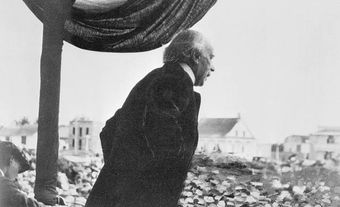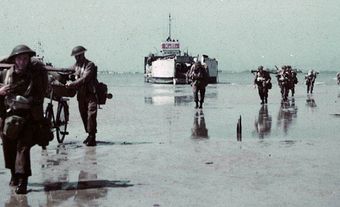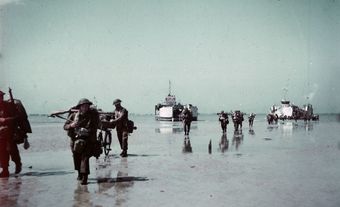The Alaska Highway was constructed from 1942 to 1943 during the Second World War. It went from Dawson Creek, British Columbia to Alaska.
Construction
During the Second World War, Alaska was threatened by the possibility of a Japanese invasion. (See also Internment of Japanese Canadians.) A preliminary road was rammed through forest wilderness and five mountain ranges in only eight to ten months. Called the Alcan Military Highway, it ran from Dawson Creek to Alaska. Groups of US Army engineers worked from several starting points to build the road.
The following year it became a permanent, all-weather, gravel-surfaced road that was 7 to 8 m wide and 2,451 km long. Around 11,000 soldiers and some 16,000 Canadian and American civilians worked on the road. Along it were 133 bridges 6 m or longer. The project cost around $185 million dollars to complete.
Canada also contributed important sums to cover airfields and flight strips, buildings, telephone systems and other assets, but not the construction of the highway itself.
Post-War Use
After the war, in April 1946, Canada took over the portion of the road going from Dawson Creek to the Alaska border.
The road was opened to unrestricted travel in 1948. It was regraded by Canadian army engineers. That year, the federal department of public works took charge and continued to improve the road. Some of the road has been paved, but much of it is bituminous surface-treated. Today, the highway has over 300,000 visitors every year.
Maintenance is a continual battle against nature. Floods and landslides in threaten the road. Blizzards and extreme cold are also a reality in winter. The road’s maintenance in Canada is the shared responsibility of the federal government as well as British Columbia and the Yukon.
Although originally built for military purposes, the highway has helped the forestry, oil, mining, tourist and trucking industries. It contributed to the development of Edmonton which supplied the highway’s construction. The highway is an enduring link to northern British Columbia and the Yukon.

 Share on Facebook
Share on Facebook Share on X
Share on X Share by Email
Share by Email Share on Google Classroom
Share on Google Classroom





